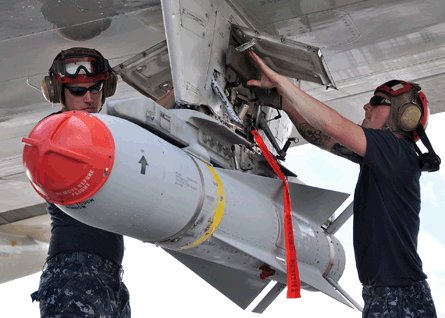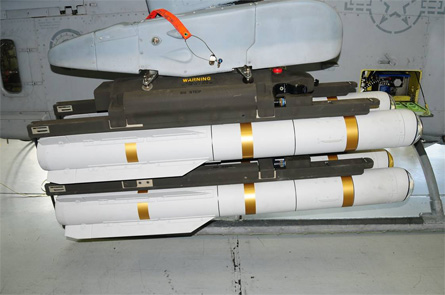A competition that could redefine the US industrial base for air-launched weapons will enter its final phase in October, after a two-year technology demonstration effort that yielded mixed results for the rival bidders.
The US Army is expected to issue a request for proposals in mid-October for the joint air-to-ground missile (JAGM) contract, with a decision between Lockheed Martin and a Raytheon/Boeing team set for the second quarter of 2011.
The process to award the last in a series of major air-to-ground missile contracts has been long and arduous.
 |
|---|
© Lockheed Martin |
The Department of Defense terminated a Lockheed contract to develop the joint common missile (JCM) in 2006. The army then relaunched a competition for a tri-mode seeker-equipped weapon to replace the company's AGM-114 Hellfire (above) and Raytheon's AGM-65 Maverick (below) with a single, 49kg (108lb) missile.
 |
|---|
© US Navy |
Lockheed re-entered the race using technology first developed for JCM, including a cooled imaging infrared (I²R) seeker. Raytheon, meanwhile, teamed up with Boeing, combining the latter's MBDA Brimstone-based missile body with its tri-mode seeker, which features an uncooled I²R sensor.
Both contractors face a long list of requirements drafted to accommodate the needs of at least seven different aircraft platforms operated by the US Army and US Navy, including fighters, helicopters and unmanned air vehicles.
Unlike the Hellfire, the JAGM must survive on fast-moving jets, requiring stronger construction and sturdier propellant that can operate in frigid temperatures down to -65°C (-85°F). The new missile also must be able to see and hit targets at 16km (8.6nm), or twice the range of a helicopter-launched Hellfire.
But the key requirement is to overcome when bad weather obscures a moving target from both a semi-active laser and an I²R sensor. This has forced both teams to integrate a millimetre-wave radar, which can "see through" fog and rain.
Heeding a then-new acquisition policy, the army in September 2008 funded both teams to complete a 27-month technology demonstration phase, including three live fire shots to test the performance of each sensor in the tri-mode seeker.
Those flight tests are now complete, with the Raytheon/Boeing team having scored three direct hits and Lockheed having missed two of the three targets.
In a recent interview, Lockheed programme director Frank St John notes the technology demonstration was not intended to serve as a "shoot-off" between the two competitors. It was instead set up to gather data, he says.
Lockheed's first test shot using a semi-active laser struck the target, but the second, 4km-range shot demonstrating the I²R sensor missed by about 400m (1,300ft). However, the I²R seeker cleared a key data point by locking on to its target, St John says.
 |
|---|
© Lockheed Martin |
Lockheed's candidate uses a cooled imaging infrared seeker |
Moreover, post-flight analysis showed that the critical tri-mode seeker technology was not at fault for missing the target. A small bracket holding an electric motor for a sensor "had an interference issue", St John says.
Lockheed was still investigating the cause of an anomaly detected on a third test on 10 September that caused the "missile to impact outside of the target", the company says. It adds that it is looking forward to captive carry tests on a Boeing F/A-18 later this year, where it believes its cooled I²R sensor will prove more reliable than Raytheon's uncooled design.
Michael Riley, Raytheon's senior business development manager, says the company's internal analysis shows that materials for the seeker dome accommodating an I²R seeker have fully matured. Such materials differ from a cooled I²R because the sensors operate in different wavelengths.
Both companies acknowledge that Lockheed's cooled I²R technology provides superior detection range. "In some conditions, the standoff range can be 50% greater than the uncooled alternative that has been traded out [by Raytheon]," St John says.
In the most challenging real-world scenario, a pilot will depend on the JAGM's I²R sensor to identify targets in close proximity to friendly troops at standoff range, St John says.
Raytheon, however, argues that a pilot in that scenario will already have an infrared-based surveillance and targeting system onboard the platform that is superior to the missile's tri-mode seeker.
 |
|---|
© Raytheon |
The Raytheon/Boeing team scored three direct hits during tests |
That allows Raytheon to offload the most challenging part of the standoff detection requirement to the host platform, allowing the missile's I²R technology to rely on a more affordable uncooled sensor, Riley says.
The seeker technology represents critical choice in a heated competition. The winner is expected to deliver 33,000 missiles and lock up the air-to-ground missile market now dominated by Lockheed's Hellfire for at least the next two decades.
In August, the US Air Force selected Raytheon to build the small diameter bomb increment II weapon, which features a similar uncooled I²R sensor in a tri-mode seeker. The losing bidder for SDB II was a Lockheed/Boeing team.
Source: Flight International
















